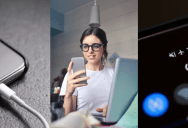Cell Phone Battery Myths And Truths You Should Know
by Ethan Cotler
A large part of owning a cell phone is knowing how and when to charge it. You always want your batteries in top-notch shape so you always have your phone available to you when you need it.
Since there’s a lot of misinformation about how to treat your phone battery, we’re going to share some common myths and truths about making sure your battery operates at peak performance.
Don’t keep your phone plugged in overnight.
This is true.
Smartphones today prevent overcharging, so it’s safe to plug your phone in at night.
Once your battery is full, it will stop taking in power. And when your phone notices a dip in battery, it will allow it to be charged again.

Airplane Mode charges faster.
This is partially true.
It reduces the phone’s function and energy output by cutting off all services.
Also, powering down your phone completely will have a similar effect as Airplane mode.
You should always keep your phone in energy-saving mode.
This is true.
This won’t harm the software but may lead to poorer user experience due to reduced functionality.
The brightness will be greatly reduced, and notifications won’t appear as soon since the phone won’t be checking for them as often.
You should charge your phone only after it dies.
This is false.
In fact, doing this consistently can be harmful to your battery.
It’s better to recharge before the battery reaches zero, as completely draining lithium-ion batteries can affect their capacity level.

Wi-Fi and Bluetooth drain the battery.
This is true.
Even if you’re not connected to Wi-Fi or Bluetooth, your phone will constantly be seeking them. Older phone models particularly suffer from this.
However, it’s worth noting that modern smartphones handle them more efficiently, so you won’t see a dramatic battery decrease by leaving them on.

Always use the original charger.
This is true.
An unofficial charger might supply too much current or cause overheating, damaging your battery’s health and safety.
This isn’t to say all off-brand chargers are hazardous.
However, the manufacturer’s product will always be a safer choice since it’s been tested on your device.
Don’t touch your smartphone while charging.
This is false.
You can operate your device while charging. However, open apps will drain the battery, causing your phone to take longer to fully charge up.
So, if you’re trying to be timely, limiting your phone use while charging is recommended.

You must eject when it’s connected to a computer.
This is true.
If your phone is plugged into your computer while you’re transferring files and you unplug it without ejecting, it could potentially damage your files.
However, if your phone is, let’s say, plugged into a wall where no file transfer is occurring, it’s completely safe to unplug it at any point.
Some misconceptions around cell phone batteries can waste time and, more importantly, even harm the battery.
Now you know the proper way to treat it!

Sign up to get our BEST stories of the week straight to your inbox.




